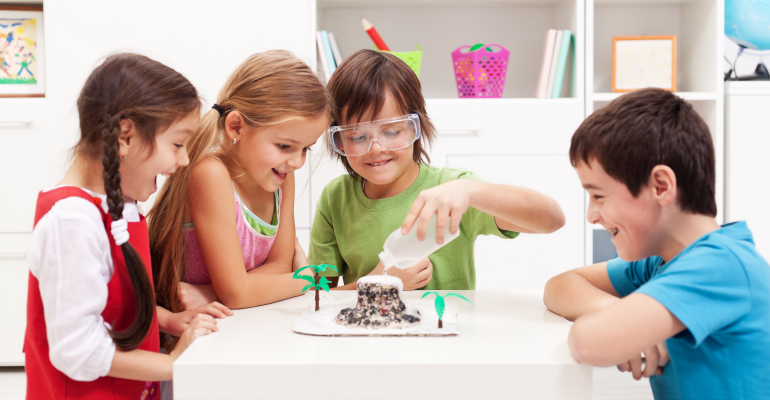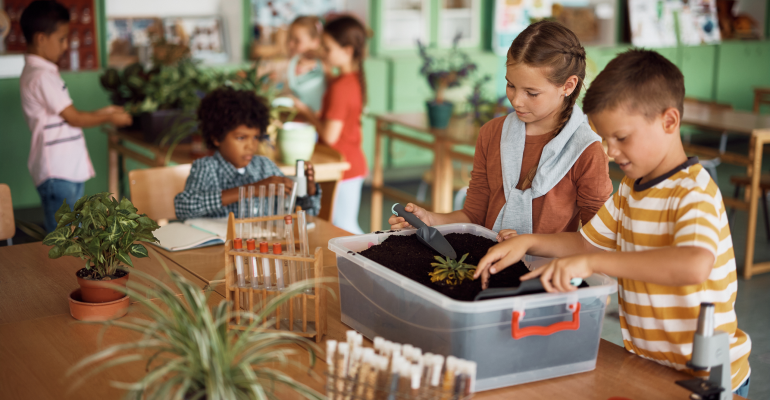Spring is just around the corner, which makes it the perfect time to explore fun new science projects with your first grade class! Here’s a list of engaging STEM activities to try this spring.

As winter thaws, spring blossoms with new ways to explore the natural wonders outside the classroom. From new floral growth and new fauna births to investigating the building blocks of the natural and physical world around us, spring is a wonderful time to bring the topics of science to life for young learners.
Here are some fun and easy STEM science projects for your first grade class this spring.
STEM Science Projects for 1st Graders
In the first grade, students are naturally curious about the natural world and how things work. This opens the doors for opportunities for classroom science projects that introduce the foundational fluencies of STEM.
1st Grade Science Project Ideas for the Classroom
STEM science projects for the first grade should be simple, fun, and engaging. These young learners are already curious about the world around them and are excellent creative thinkers. Being able to connect the real-world outdoors to the concepts they’re learning in the classroom is a powerful way to kickstart their STEM knowledge and set students up for success in their STEM education.
1. Explore the Great Outdoors
Once the weather warms, it’s a great time to venture out of the classroom and explore the great outdoors with your first grade class.
Nature Bingo is a fun and easy spring STEM activity that will have your first graders excited to discover the natural world around them. You can download nature bingo templates online from a number of resources, including the Massachusetts Audubon Website, which offers free downloads of nature bingo for all four seasons.
If you’re feeling especially creative, you can always create your own Nature Bingo cards with local rarities and finds!
2. Use Natural Resources
A fresh update on the decades-old egg-carrying activity goes beyond teaching students about empathy, compassion, and the messiness of a broken egg—but teaches them about resourcefulness, recycling, and how animals care for their young in nature.
First, introduce recycling and reuse in the classroom—this Reducing Our Impact on Earth lesson plan can help get you started. Then, using this nest-assembling lesson plan, invite your first graders to build a nest for an egg using all recycled materials. They can be from nature, the recycling bin, or a new way to reuse an old item.
Have each student assemble their nests in class to create a soft and safe place for an egg to land, just as birds do for the eggs in their nest.
By integrating multiple lessons and activities, students get to see the connection between life and natural resources and how to be resourceful in their daily lives.

3. Integrate Science into Other School Subjects
Add science lessons to other school subjects throughout the day to keep students engaged in STEM and notice the connections STEM has to their other learning activities.
One way to do this is to add STEM books during storytime where you can discuss new ideas with your class and invite their own curiosities and creative thoughts.
Another way to integrate STEM subjects is to provide context for a lesson plan. For example, in Cougar Crossing by Meeg Pincus, a cougar named P-22 makes an treacherous journey across Los Angeles, inspiring the construction of a wildlife bridge across Highway 101 so other animals don’t have to make the same trip. Pairing this storybook with the engineering and bridge building exercises in Kid Spark’s 1st grade STEM program is an excellent way to bring context and understanding of how STEM applies to the real world.
We’ve made a list of our 8 Best Picks for STEM Reading in Elementary School Classrooms, but you might also enjoy these science-specific reads:
-
- Cougar Crossing by Meeg Pincus
- A Warmer World by Caroline Arnold
- Fairy Science by Ashley Spires
- What’s the Weather by Fraser Ralston and Judith Ralston
You might also take advantage of spring’s good weather with outdoor math activities, like creating a giant outdoor chalk clock or bowling with numbers.
4. Celebrate Earth Day
Teach your first graders to connect with nature and give back to the earth with fun Earth Day science activities for spring.
The Sode Bottle Compost activity is a fun hands-on science activity that can keep students entertained for weeks. Incorporate compost journals or use the compost bottles to inspire conversations in the classroom about decomposition and the natural cycles of regeneration on Earth.
Or, explore these recycling games and resources from PBS to practice year-round conservation.
5. Follow the Stars
What better way to engage students in a lifelong curiosity in science than connecting lessons to current events? By following the latest astronomical events, you can time classroom lesson plans to correspond with space events like meteor showers, visible planets, or eclipses.
Inspire and excite your first grade class with activities like Understanding Light Pollution (with only black construction paper and a flashlight), building NASA Soda-Straw Rockets, or exploring energy and movement while learning how the Moon got its craters with this Creating Craters STEM Activity. With just a few materials (and a spacious area to get a little messy), this fun science project will have your first graders eager to explore space on their own.

6. Discover Design and Construction
Now that it’s warm enough to go outside, it’s time to take in the local engineering sights of bridges, buildings, and structures. Spring science projects aren’t just for life and earth sciences, it’s a great time to practice design, building, and construction.
At Kid Spark, our Foundational Fluencies STEM Lab helps students discover the fundamental elements of STEM for a headstart in their STEM education. With a combination of lesson plans, design challenges, and free-building activities, first grade students are introduced to the building blocks of STEM with all the teaching materials and reusable materials you need!
7. Utilize Outside Space
Some science projects are just too big for the classroom, and springtime is an excellent time to venture outdoors for some larger-than-life science experiments.
Take the Soda Explosion science project, for example. With some Diet Coke, Mentos, and construction paper, you’ll have a memorable outdoor science project to highlight chemical reactions, pressure, and the force of carbon dioxide.
Or, utilize the power of the sun for fun science craft projects like making sun prints.
8. Cultivate New Growth
Celebrate the spring season with new ways to explore the plant life cycle with your first grade class. Learning how plants grow can create a new appreciation for nature in young students and help them see the connections between STEM at school and STEM in the real world.
Growing a seed jar is a perfect spring science project that helps first graders understand how a plant grows from a single seed. Or, create your own plantable seed paper as a class and let students add their own designs to the final product. (These also make unique Mother’s Day gifts!)
For more fun STEM science projects for first grade, check out the free resources available through sites like NASA or PBS.
1st Grade STEM Curriculum with Kid Spark
Kid Spark Education’s mission is to provide access to STEM education for all students. We know that students thrive with early and consistent access to STEM, and we’re passionate about developing science-backed STEM curricula to support students on their lifelong journey through STEM.
That’s why we craft specialized STEM science projects for students from Pre-K—8th Grade. Our lesson plans are designed to meet The Next Generation Science Standards (NGSS) and are sequentially designed to build on previous STEM knowledge from previous lessons and activities.
While fun spring science projects play an important role in exploring new STEM concepts, a structured STEM curriculum helps students define their learning through convergent and divergent learning activities to build the foundations of STEM success.

The Benefits of Designing STEM Science Projects Within a Curriculum
Here are just some of the benefits of science-backed STEM lesson plans and science projects for first graders:
- Compounding Knowledge
Kid Spark STEM programs start at Pre-K and extend to the 8th grade. Within these years, students are building on their STEM education from previous years and being challenged with new ways to utilize their STEM knowledge.
Because Kid Spark STEM programs are designed for multiple grade levels, units of instruction, lesson plans, and design challenges, each aspect of the curriculum fits into a larger whole. This comprehensive approach provides the highest quality STEM education and prevents learning gaps throughout the different grade levels.
- Consistent Education
Just as important as early access is consistency when providing effective STEM instruction. Kid Spark STEM programs follow a consistent schedule for regular science projects and activities that can take place throughout the school year.
Other science projects (like the ones listed above) are great for interspersing throughout these structured lesson plans and activities, but the consistency of a comprehensive curriculum creates a solid foundation for young learners to rely on for regular engagement with STEM concepts.
- The Right Amount of Challenge
Kid Spark programs are designed to keep students in the Zone of Proximal Development - a concept created by psychologist Lev Vygotsky. It is in this zone where students feel challenged, excited, alive, engaged, and motivated and where the most learning and development occur.
Finding this zone in STEM lesson planning requires designing activities that are engaging and approachable but not too simple and not too difficult. This Goldilocks zone should not be too easy and within the realm of what a student can already do (as they would get bored too easily), nor should it be too challenging and beyond a student’s reach (as they might get discouraged and give up).
At Kid Spark, we create lesson plans and activities that keep students of all levels engaged and just challenging enough to find the zone of proximal development. For students of all backgrounds and abilities, our lesson plans can be adapted so that everyone is included and motivated to learn.
- STEM Integration
With a comprehensive curriculum, first grade students are exposed to all subjects of STEM. Aligning with NGSS, our lessons, and activities build the foundations of STEM across multiple subjects.
From the earliest STEM program, first graders become well-versed in critical thinking, logical and sequential reasoning, and creative problem-solving. All these skills can be utilized in science, technology, engineering, or mathematics—forming a formidable foundation on which more complex STEM subjects can be built.
- Tools for Teachers
Finally, another benefit of utilizing a designed STEM curriculum for your first grade class is the library of tools and resources you gain as an educator.
Not only do you receive an all-in-one solution complete with curriculum, instruction tools, lesson plans, activities, unit assessments, rubrics, and reusable materials, but you also receive professional learning resources so you can feel confident in the STEM ideas you’re sharing with your class.
Rather than purchasing or finding resources and materials for individual science projects and lesson plans, you have everything you need in a single STEM program designed with you and your students in mind.

How to Get Started with Kid Spark’s 1st Grade Science Projects
If you’re ready for an all-in-one STEM solution for your first grade classroom, connect with us today to plan your program.
We’re dedicated to exposing students to STEM early and often and supporting STEM mentors like you to help lead them on their educational journey. While ease of adoption and program costs have historically kept STEM out of elementary education, Kid Spark is the lowest-cost school-wide STEM solution available and has been readily adopted by elementary teachers across the nation.
Contact us today for any questions about bringing Kid Spark STEM programs to your school.
.png?width=1270&height=453&name=Copy%20of%20Kid%20Spark%20Logo%20(Horizontal%20-%20Full%20Color).png)